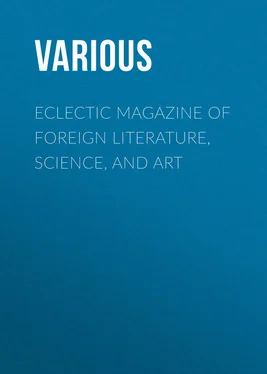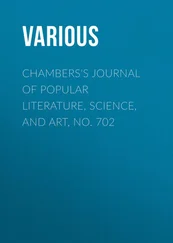Various - Eclectic Magazine of Foreign Literature, Science, and Art
Здесь есть возможность читать онлайн «Various - Eclectic Magazine of Foreign Literature, Science, and Art» — ознакомительный отрывок электронной книги совершенно бесплатно, а после прочтения отрывка купить полную версию. В некоторых случаях можно слушать аудио, скачать через торрент в формате fb2 и присутствует краткое содержание. Жанр: foreign_home, на английском языке. Описание произведения, (предисловие) а так же отзывы посетителей доступны на портале библиотеки ЛибКат.
- Название:Eclectic Magazine of Foreign Literature, Science, and Art
- Автор:
- Жанр:
- Год:неизвестен
- ISBN:нет данных
- Рейтинг книги:4 / 5. Голосов: 1
-
Избранное:Добавить в избранное
- Отзывы:
-
Ваша оценка:
- 80
- 1
- 2
- 3
- 4
- 5
Eclectic Magazine of Foreign Literature, Science, and Art: краткое содержание, описание и аннотация
Предлагаем к чтению аннотацию, описание, краткое содержание или предисловие (зависит от того, что написал сам автор книги «Eclectic Magazine of Foreign Literature, Science, and Art»). Если вы не нашли необходимую информацию о книге — напишите в комментариях, мы постараемся отыскать её.
Eclectic Magazine of Foreign Literature, Science, and Art — читать онлайн ознакомительный отрывок
Ниже представлен текст книги, разбитый по страницам. Система сохранения места последней прочитанной страницы, позволяет с удобством читать онлайн бесплатно книгу «Eclectic Magazine of Foreign Literature, Science, and Art», без необходимости каждый раз заново искать на чём Вы остановились. Поставьте закладку, и сможете в любой момент перейти на страницу, на которой закончили чтение.
Интервал:
Закладка:
Here he not only discovered, with a 6-inch achromatic, mounted as need prescribed, several very close stellar pairs, of which Sir John Herschel’s 18 inch speculum had given him no intelligence; but in a few nights’ “sweeping” with a very small Vogel’s spectroscope, he just doubled the known number of a restricted, but particularly interesting, class of stars – if stars indeed they be. For while in the telescope they exhibit the ordinary stellar appearance of lucid points, they disclose, under the compulsion of prismatic analysis, the characteristic marks of a gaseous constitution; that is to say, the principal part of their light is concentrated in a few bright lines. The only valid distinction at present recognisable by us between stars and “nebulæ” is thus, if not wholly abolished, at least rendered of a purely conventional character. We may agree to limit the term “nebulæ” to bodies of a certain chemical constitution; but we cannot limit the doings of Nature, or insist on the maintenance of an arbitrary line of demarcation. From the keen rays of Vega to the undefined lustre of the curdling wisps of cosmical fog clinging round the sword-hilt of Orion, the distance is indeed enormous. But so it is from a horse to an oak tree; yet when we descend to volvoxes and diatoms, it is impossible to pronounce off-hand in which of the two great provinces of the kingdom of life we are treading. It would now seem that the celestial spaces have also their volvoxes and diatoms – “limiting instances,” as Bacon termed such – bodies that share the characters, and hang on the borders of two orders of creation.
In 1867, MM. Wolf and Rayet, of Paris, discovered that three yellow stars in the Swan, of about the eighth magnitude possessed the notable peculiarity of a bright-line spectrum. It was found by Raspighi and Le Sueur to be shared by one of the second order of brightness in Argo (γ Argûs), and Professor Pickering, of Harvard, reinforced the species, in 1880-81, with two further specimens. Dr. Copeland’s necessarily discursive operations on the shores of Lake Titicaca raised the number of its members at once from six to eleven or twelve. Now the smaller “planetary” nebulæ – so named by Sir William Herschel from the planet-like discs presented by the first-known and most conspicuous amongst them – are likewise only distinguished from minute stars by their spectra. Their light, when analysed with a prism, instead of running out into a parti-colored line, gathers itself into one or more bright dots. The position on the prismatic scale of those dots, alone serves to mark them off from the Wolf-Rayet family of stars. Hence the obvious inference that both nebulæ and stars (of this type) are bodies similar in character, but dissimilar in constitution – that they agree in the general plan of their structure, but differ in the particular quality of the substances glowing in the vast, incandescent atmospheres which display their characteristic bright lines in our almost infinitely remote spectroscopes. Indeed, the fundamental identity of the two species are virtually demonstrated, by the “migrations” (to use a Baconian phrase) of the “new star” of 1876, which, as its original conflagration died out, passed through the stages, successively, of a Wolf-Rayet or nebular star (if we may be permitted to coin the term), and of a planetary nebula. So that not all the stars in space are suns – at least, not in the sense given to the word by our domestic experience in the solar system.
The investigation of these objects possesses extraordinary interest. As an index to the true nature of the relation undoubtedly subsisting between the lucid orbs and the “shining fluid” which equally form part of the sidereal system, their hybrid character renders them of peculiar value. Their distribution – so far restricted to the Milky Way and its borders – may perhaps afford a clue to the organisation of, and processes of change in that stupendous collection of worlds. At present, speculation would be premature; what we want are facts – facts regarding the distances of these anomalous objects – whether or not they fall within the range of the methods of measurement at present available; facts regarding their apparent motions; facts regarding the specific differences of the light emitted by them: its analogies with that of other bodies; its possible variations in amount or kind. The accumulation of any sufficient information on these points will demand with every external aid, the patient labor of years; under average conditions at the earth’s surface, it can scarcely be considered as practically feasible. The facility of Dr. Copeland’s discoveries sufficiently sets off the prerogatives, in this respect, of elevated stations; it is not too much to say that this purpose – were it solely in view – would fully justify the demand for their establishment.
Towards one other subject which we might easily be tempted to dwell upon, we will barely glance. Most of our readers have heard something of Dr. Huggins’s new method of photographing the corona. Its importance consists in the prospect which it seems to offer for substituting for scanty and hurried researches during the brief moments of total eclipse, a leisurely and continuous study of that remarkable solar appendage. The method may be described as a differential one. It depends for its success on the superior intensity of coronal to ordinary sunlight in the extreme violet region. And since it happens that chloride of silver is sensitive to those rays only in which the corona is strongest, the coronal form disengages itself photographically, from the obliterating splendor which effectually shrouds it visually, by the superior vigor of its impression upon a chloride of silver film.
Now if this ingenious mode of procedure is to be rendered of any practical avail, advantage must, above all, be taken of the finer air of the mountains. This for two reasons. First, because the glare which, as it were, smothers the delicate structure we want to obtain records of, is there at a minimum; secondly, because the violet rays by which it impresses itself upon the “photographic retina” 30 30 An expression used by Mr. Warren de la Rue.
are there at a maximum. These, as Professor Langley’s experiments show, suffer far more from atmospheric ravages than their less refrangible companions in the spectrum; the gain thus to them, relatively to the general gain, grows with every yard of ascent; the proportion, in other words, of short and quick vibrations in the light received becomes exalted as we press upwards – a fact brought into especial prominence by Dr. Copeland’s solar observations at Vincocaya, 14,360 feet above the sea-level. Indeed, for all the operations of celestial photography, the advantages of great altitudes can hardly be exaggerated; and celestial photography is gradually assuming an importance which its first tentative efforts, thirty-four years ago, gave little reason to expect.
Thus, in three leading departments of modern astronomy – solar physics, stellar spectroscopy, and the wide field of photography – the aid of mountain observatories may be pronounced indispensable; while in all there is scarcely a doubt that it will prove eminently useful. There are, indeed, difficulties and drawbacks to their maintenance. The choice of a site, in the first place, is a matter requiring the most careful deliberation. Not all elevated points are available for the purpose. Some act persistently as vapor-condensers, and seldom doff their sullen cap of clouds. From any mountain in the United Kingdom, for instance, it would be folly to expect an astronomical benefit. On Ben Nevis, the chief amongst them, a meteorological observatory has recently been established with the best auguries of success; but it would indeed be a sanguine star-gazer who should expect improved telescopic opportunities from its misty summit.
Читать дальшеИнтервал:
Закладка:
Похожие книги на «Eclectic Magazine of Foreign Literature, Science, and Art»
Представляем Вашему вниманию похожие книги на «Eclectic Magazine of Foreign Literature, Science, and Art» списком для выбора. Мы отобрали схожую по названию и смыслу литературу в надежде предоставить читателям больше вариантов отыскать новые, интересные, ещё непрочитанные произведения.
Обсуждение, отзывы о книге «Eclectic Magazine of Foreign Literature, Science, and Art» и просто собственные мнения читателей. Оставьте ваши комментарии, напишите, что Вы думаете о произведении, его смысле или главных героях. Укажите что конкретно понравилось, а что нет, и почему Вы так считаете.












